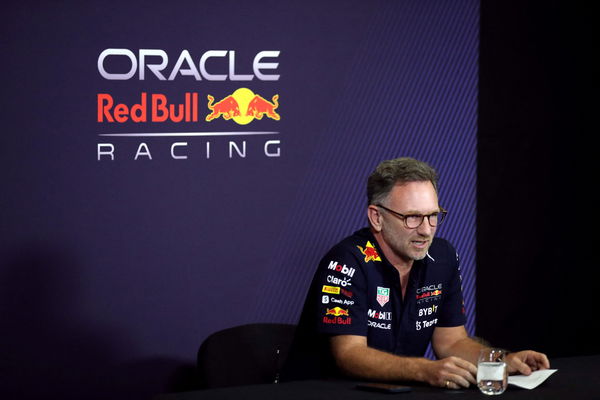
via Reuters
Formula One F1 – Mexico City Grand Prix – Autodromo Hermanos Rodriguez, Mexico City, Mexico – October 28, 2022 Red Bull team principal Christian Horner during a press conference REUTERS/Edgard Garrido

via Reuters
Formula One F1 – Mexico City Grand Prix – Autodromo Hermanos Rodriguez, Mexico City, Mexico – October 28, 2022 Red Bull team principal Christian Horner during a press conference REUTERS/Edgard Garrido
Red Bull can just fantasize about how every season they can be as successful as in 2022. The manner in which the Milton Keynes outfit claimed 759 points with 17 wins plus multiple podiums, was perhaps utopian. Yet, now they gotta deal with a dicey situation for being the world champion. The FIA have got a rule that certainly would not please the finance department at Red Bull Racing.
According to Auto Motor und Sport, Red Bull has to pay up a hefty check of entry fees for the upcoming 2023 season. These entry fee dues are worth $6.2 million. This amount bifurcates into the flat entry fee mandatory for every constructor and an amount for every point the team scored in the previous championship.

via Reuters
Formula One F1 – French Grand Prix – Circuit Paul Ricard, Le Castellet, France – July 24, 2022 Red Bull Team Principal Christian Horner during the race REUTERS/Eric Gaillard/Pool
As per the FIA rules, every constructor has to pay up a flat fee worth $617,687. The per-point amount for every team is $6,174. But, for the champion team, this goes up to $7,411.
ADVERTISEMENT
Article continues below this ad
Thus, Red Bull’s dues add up to $6,242,636 for their 759 points from 2022 and including the flat fee of $617K. Despite being already down with the budget cap breach fine, this is an additional financial constraint for RBR. In contrast, Ferrari has to pay about $4.03 million for 2023. While Mercedes has received a bill of $3.79 million.
Eventually, the Austrian team may be happy to pay as they are the champions. Still, it is a hefty due bill for winning the championship. Especially when they got an important 2023 season with the budget cap penalty.
Read More: Red Bull Breaks Down Waving the White Flag On $7 Million Battle With “Draconian” FIA
Yet, Red Bull’s main focus will be to tackle the effects of its budget cap penalty. With a $7 million penalty and a 10% aero testing time reduction; the Milton Keynes outfit has to manage the loss of performance gains as well as their budgets.
How will Red Bull be affected by the Cost Cap Penalty for 2023
Red Bull’s budget cap breach certainly has cost them a crucial chunk of development time for its 2023 car. The RB19 already had a reduced wind tunnel time due to RBR being the champion. Thus they only get 70% wind tunnel testing as per the sliding scale of the aero testing regulations.

via Reuters
Formula One F1 – Japanese Grand Prix – Suzuka Circuit, Suzuka, Japan – October 8, 2022 Red Bull’s Max Verstappen during practice REUTERS/Issei Kato
Though, now with the 10% reduction with the cost cap penalty, this time is roughly reduced by about 7% more. Still, how does this affect in loss of lap time gains for Red Bull? As per The Race, the Milton Keynes team will have even fewer wind tunnel runs and CFD test items relative to its rivals Ferrari and Mercedes.
Meanwhile, the Scuderia and the Silver Arrows can actually benefit from Red Bull’s testing handicap. For instance, Ferrari which is Red Bull’s nearest rival, finishing 2nd in 2022; gets 38 more wind tunnel runs and 240 more CFD items than RBR over an 8-week period. This deficit can equate to a lot of lap time gain for the Maranello outfit.
ADVERTISEMENT
Article continues below this ad
While, Mercedes have this benefit extended, as they finished 3rd in 2022. Thus, the Brackley team can gain a good amount of performance relative to the top two in 2023.
ADVERTISEMENT
Article continues below this ad
WATCH THIS STORY: Max Verstappen and Christian Horner slam Mercedes for taking the shine off F1 Title win
Still, Red Bull can work out these effects and mitigate their performance losses; if they plan the car development efficiently. It is all about balancing and maximizing the available testing opportunities. What do you think? Can the Austrian team mitigate the effects of this budget cap penalty?
ADVERTISEMENT
ADVERTISEMENT
ADVERTISEMENT
ADVERTISEMENT

